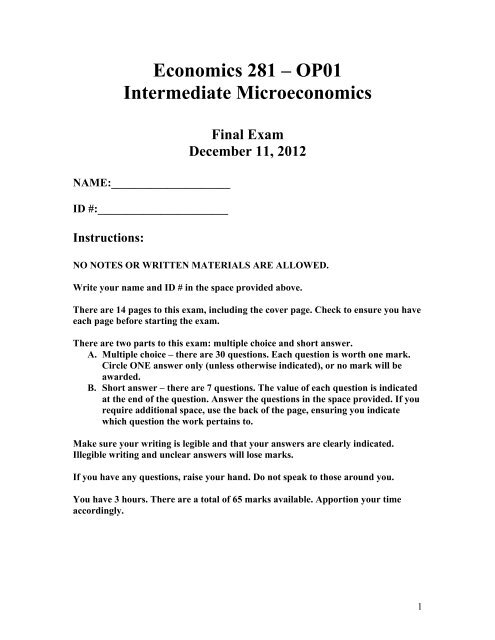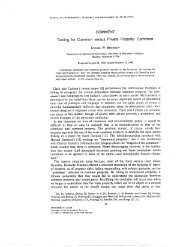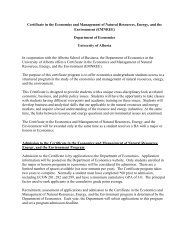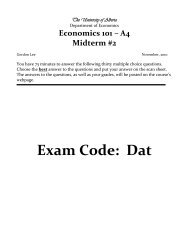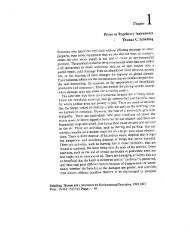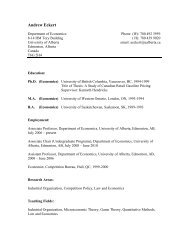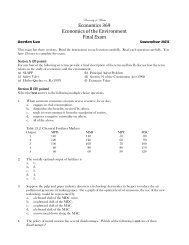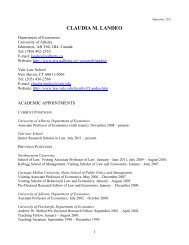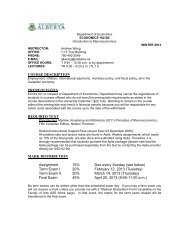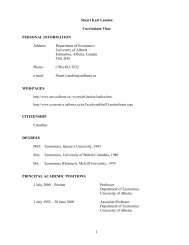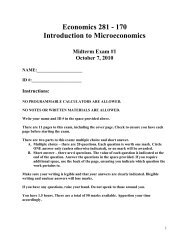Fall 2012 Final Exam
Fall 2012 Final Exam
Fall 2012 Final Exam
Create successful ePaper yourself
Turn your PDF publications into a flip-book with our unique Google optimized e-Paper software.
Economics 281 – OP01Intermediate MicroeconomicsNAME:_____________________ID #:_______________________Instructions:<strong>Final</strong> <strong>Exam</strong>December 11, <strong>2012</strong>NO NOTES OR WRITTEN MATERIALS ARE ALLOWED.Write your name and ID # in the space provided above.There are 14 pages to this exam, including the cover page. Check to ensure you haveeach page before starting the exam.There are two parts to this exam: multiple choice and short answer.A. Multiple choice – there are 30 questions. Each question is worth one mark.Circle ONE answer only (unless otherwise indicated), or no mark will beawarded.B. Short answer – there are 7 questions. The value of each question is indicatedat the end of the question. Answer the questions in the space provided. If yourequire additional space, use the back of the page, ensuring you indicatewhich question the work pertains to.Make sure your writing is legible and that your answers are clearly indicated.Illegible writing and unclear answers will lose marks.If you have any questions, raise your hand. Do not speak to those around you.You have 3 hours. There are a total of 65 marks available. Apportion your timeaccordingly.1
PART A – MULTIPLE CHOICE(30 marks total)1. For a market to be perfectly competitive,a. Firms must have market power, firms must produce a differentiated product, andfirms must be able to easily enter and exit the market.b. Firms must be price takers, firms must produce a homogeneous product, and firmsmust be able to easily enter and exit the market.c. Only one firm can have access to a key input, the government must regulate entryof new firms, and the long-run average cost of production must be decreasing.d. Only a few firms may produce output, firms must have market power, and firmsmust produce a homogeneous product.e. None of the above.2. The amount of output that a firm decides to sell has no effect on the market price in acompetitive industry becausea. The firm’s output is a small fraction of the entire industry’s outputb. The market price is determined (through regulation) by the governmentc. The short run market price is determined solely by the firm’s technologyd. The demand curve for the industry’s output is downward slopinge. The firm supplies a different good than its rivals3. Short run supply curves for perfectly competitive firms tend to be upward slopingbecausea. Marginal costs increase as output increasesb. There is diminishing marginal product for one or more variable inputsc. Marginal fixed costs equal zerod. (a) and (b) are correcte. (b) and (c) are correct4. The burden of a tax is shared by producers and consumers. Under what conditions willconsumers pay most of the tax? Under what conditions will producers pay most of it?a. It depends on who is legally obligated to pay the tax. Typically, consumers arerequired to pay the tax and therefore bear most of the burden.b. If demand is relatively more elastic than supply, consumers will pay more of thetax.c. If demand is relatively less elastic than supply, consumers will pay more of thetax.d. It depends on who is legally obligated to pay the tax. Typically, producers arerequired to pay the tax and therefore bear most of the burden.2
22. If firms can easily enter and exit a market, thena. Firms will produce where price is greater than marginal revenueb. Firms will earn zero economic profit in the short runc. Firms will produce at minimum average cost in the long rund. Firms will produce at minimum average fixed cost in the long run23. Isocost lines are straight because the slope of such linesa. Equals the marginal rate of technical substitution, which is fixedb. Equals the ratio of the marginal products of the inputs, which is fixedc. Equals the ratio of sunk costs to opportunity costs, which is diminishingd. Equals the ratio of input prices, which is increasinge. Equals the ratio of input prices, and these prices are fixed24. Evaluate the truth of the following two statements:I. Increasing returns to scale cause economies of scaleII. Economies of scale cause increasing returns to scalea. Both I and II are trueb. I is false, and II is truec. Both I and II are falsed. I is true, and II is false25. What is the difference between economic profit and producer surplus?a. Economic profit includes fixed costs but producer surplus does not.b. Economic profit includes variable costs but producer surplus does not.c. Producer surplus includes marginal costs but economic profit does not.d. Producer surplus includes opportunity costs but economic profit does not.e. Economic profit includes government taxes but producer surplus does not.26. In a constant-cost industry, an increase in demand will be followed bya. An increase in supply that will not change price from the higher level that occursafter the demand shift.b. An increase in supply that will bring price down below the level it was before thedemand shift.c. A decrease in demand to keep price constant.d. An increase in supply that will bring price down to the level it was before thedemand shift.e. No increase in supply.7
27. Suppose a firm can practice perfect first-degree price discrimination. The lowest priceand total output will occur at the point wherea. The marginal cost curve intersects the marginal expenditure curveb. The demand curve intersects the supply curvec. The average cost curve intersects the demand curved. The marginal revenue curve intersects the marginal cost curvee. The marginal cost curve intersects the demand curve28. Bette’s Breakfast, a perfectly competitive eatery, sells its “Breakfast Special” (theonly item on the menu) for $5.00. The costs of waiters, cooks, power, food, etc. averageout to $3.95 per meal; the costs of the lease, insurance and other such expenses averageout to $1.25 per meal. Bette shoulda. Raise her prices above the perfectly competitive levelb. Close her doors immediatelyc. Continue producing in the short run, but plan to go out of business in the long rund. Lower her outpute. Continue producing in the short and long run29. A firm’s cost-output elasticity equals 1.4. This implies thata. There are diseconomies of scaleb. There are neither economies nor diseconomies of scalec. There are economies of scaled. Marginal cost is less than average cost30. Why is there no market supply curve under conditions of monopoly?a. Since the monopolist is the only firm in the market, it simply allows its marginalcost curve to act as the “monopolist’s” supply curve.b. Output decisions depend not only on marginal cost but also on the demand curve.Shifts in demand lead to changes in output but not price. Thus, there is no one-toonecorrespondence between price and the seller’s quantity.c. Output decisions depend not only on marginal cost but also on the demand curve.Shifts in demand lead to changes in price, output, or both. Thus, there is no oneto-onecorrespondence between price and the seller’s quantity.d. Output decisions depend not only on marginal cost but also on the demand curve.Shifts in demand lead to changes in price but not output. Thus, there is no one-toonecorrespondence between price and the seller’s quantity.8
3. The marginal value for a monopsonist is MV = 20 – 0.25QThe average expenditure curve is AE = 0.5QThe marginal expenditure curve is ME = QThe quantity, Q, is in thousands of units.How much will the monopsonist purchase, and how much will it pay? (4 marks)11
condições no local dela não mudaram. Isto indica que o sistema campo eletromagnético não élocalizado como as partículas, mas trata-se de um sistema que preenche o espaço todo. Omovimento repentino da partícula 1 modificaria o estado do campo na vizinhança da partícula,esta mudança modificaria o estado do campo na vizinhança da vizinhança, esta mudançamodificaria o estado na vizinhança da vizinhança da vizinhança etc. até a mudança chegar no localda partícula 2. Esta visão de força é fundamentalmente diferente do conceito de força introduzidopor Newton. Na mecânica de Newton a força que uma partícula exerce sobre outra é uma ação àdistância. Na visão eletromagnética não devemos mais falar em “força que uma partícula exercesobre outra”. A condição local do campo na posição da partícula exerce a força e reciprocamenteas partículas modificam as condições locais do campo. As modificações locais propagam-se edesta forma transmitem força de uma partícula para outra.Podemos dizer que na mecânica de Newton o mundo era feito de partículas locais que interagiamglobalmente. No eletromagnetismo o mundo é feito de partículas locais e um campo global queinterage com as partículas de forma local.Temos que formalizar estas idéias para poder descrever experiências de forma quantitativa. Parauma descrição formal do campo eletromagnético, temos que atribuir a cada ponto r do espaço epara cada instante t um valor de uma determinada grandeza. Resulta que precisamos, para umadescrição completa do eletromagnetismo, não apenas uma grandeza mas logo duas grandezasvetoriais. Desta forma o campo eletromagnético seria descrito por duas funções vetoriais de r et , isto é, uma função chamada campo elétrico, E ( r , t)e uma chamada campo magnético,B ( r , t). 1 É importante notar que o vetor posição r nestas expressões não depende do tempo! Oscampos existem em todo o espaço independente da presença de uma partícula no local r . Mas seuma partícula estiver no local r então o conhecimento dos valores dos campos permite calcular aforça que atua sobre a partícula. Esta força é F = qE( r,t) + qv × B( r,t)(8)onde v é a velocidade da partícula e q sua carga.Linhas de força do campo elétricoEste novo objeto físico "campo eletromagnético" parece ser demasiado sublime e incompreensívelpara nossa mente; não podemos vê-lo nem tocá-lo com as mãos. Mas há meios de visualizar ocampo elétrico experimentalmente. A primeira experiência desta aula tem como objetivo conhecerum método para tornar um campo elétrico visível e para conhecer então algumas configurações decampo.Na experiência vamos gerar um campo elétrico forte com ajuda de um gerador de alta tensão. Aregião de campo alto ficará numa vasilha que contém um líquido não condutor e disperso nolíquido grãos de poeira de um material não condutor. No caso usamos óleo e farinha de fubá. Paraentender o que acontece vamos desenhar alguma configuração do campo elétrico e alguns grãos depoeira. Neste desenho representamos os vetores E( r ) (vamos supor um campo que não dependado tempo) por setas desenhadas em diversas posições r . A seta desenhada representa o vetorE( r ) para o ponto r que corresponde à base da seta. É bom lembrar que este tipo de desenho énaturalmente apenas uma representação simbólica parecida com um diagrama de forças da FísicaI. Afinal o vetor E( r ) não é um deslocamento no espaço físico e portanto não é uma seta, massimbolicamente pode ser representado por uma seta.1 De fato B é pseudo-vetor (vetor axial).12
5. Consider a firm that produces both flutes and piccolos.a. Draw the firm’s product transformation curve for if it experiences economies ofscope. (2 marks)b. Draw the firm’s product transformation curve for if it does not experienceeconomies of scope or diseconomies of scope. (2 marks)6. A firm in the market for designer jeans has some degree of monopoly power. Thedemand curve it faces has a price elasticity of demand of -3, while the price elasticity ofdemand for the market is -2.25. Moreover, the firm has a constant marginal cost of$65.00. What is the firm’s profit-maximizing price? (2 marks)13
7. Suppose the market for widgets can be described by the following equations:Demand: P = 18 − 1.00QSupply: P = 1.00Q − 4P is the price in dollars per unit and Q is the quantity in thousands of units.a. What is the equilibrium price and quantity? (2 marks)b. Suppose the government imposes a tax of $1 per unit. What will be the newequilibrium quantity? What price will the buyer pay? What amount per unit willthe seller receive? (4 marks)14


